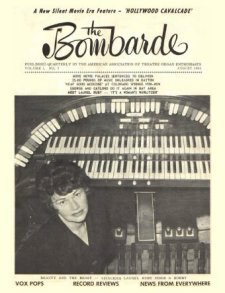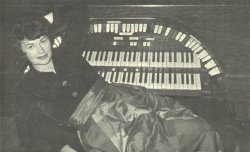


Ruby Residence - 2/4 Wurlitzer
Corvallis, Oregon
Back to the Northwest Theatre Organ History: Residences page
Meet Laurel Ruby of Corvallis, Oregon, secretary for an insurance adjustment firm, mother of Gerry, Linda, and Bruce, and probably the only woman in the world who purchased, installed, maintains, and plays her own WurliTzer theatre pipe organ.
In the converted double garage of her home reposes a WurliTzer 2 manual 4 rank Style "B" pipe organ, officially #1059, but more affectionately and commonly referred to as "The Monster." Laurel admits that it is still something of a shock to open the kitchen door and, instead of finding the car, see a neat row of swell shutters on one side and a tiled music room with a console on the other.

Four rank chest

Percussions and toy counter
Mrs. Ruby recalls a feeling of awe upon first hearing a theatre pipe organ while skating at the Oaks Roller Rink in Portland in 1945. She purchased an electric organ in 1958, and a year later--October 21st, 1959, to be exact--she was really bitten by the pipe organ "bug". On that date she paid her first visit to the Corvallis home of Dick Chase, who has a beautiful 3/14 Robert Morton/WurliTzer. She says, "I saw, heard, and felt the pipes, although I then had no dream of actually owning one." Soon after that night she made arrangements to play the only theatre installation in Corvallis, the Whiteside Theatre WurliTzer 2/8 that has since been removed and installed in Gill Coliseum at Oregon State University. She would slip down to the theatre at 2 in the morning, the janitor would let her in the side door, and she would play until the break of dawn. Laurel acknowledges that during this time the theatre organ "disease" became incurable.
Laurel says as long as she lives she will never forget the night everything was unloaded in the garage and utility room of the house she was then renting. "They kept telling me that I had bought a 'baby' WurliTzer, but the parts filled the whole double garage and I even had string pipes in the Washing machine. The "Monster" was nearly home. And it had travelled far to find that home.
Number 1059 was shipped from the WurliTzer factory to the Astoria Theatre in Astoria on May 16, 1925, In the mid-1930's it was moved to the Liberty Theatre where it remained until purchased by Blunk in 1954. He installed the pipes in his Blue-C Roller Rink, but played them first from a re-wired Hammond console, and later from an Allen. Early in 1956 Bill moved back to his home in Alexander, Indiana, accompanied by "The Monster." But in 1958 he returned to Astoria with the organ and purchased the Viking Theatre which he converted to a skating rink. In the theatre was a 3-manual Marr and Colton with chambers on either side of the arch. He moved the pipes to the stage, added the pipes and percussions from the WurliTzer, and played for skating from the Marr and Colton console. Fortunately, the original WurliTzer console had managed to keep up with the oft-moved pipes during these busy years. So there things stood until Bill purchased the Rochester behemoth and sold both his Marr and Colton and "The Monster." When No. 1059 was removed from the rink Bill was careful to see that all of the original pipework, chests, and percussions accompanied the console to Corvallis. All except the glockenspiel, that is. The WurliTzer glock was inaccessible, so Bill allowed Laurel to take the Liberty glock from the Marr and Colton instead. "I didn't know it at the time," she says proudly, "but now I am sure I have the best glock in the country!"
Loyal friends worked diligently on the project night after night in the weeks that followed. But Laurel says, "Nothing could have been done without Dick Chase. He knew everything!"Dick planned the work and performed the lion's share himself. Chauncey Chase, Dick's father, advised and aided on lacquering and refinishing the console, while Dick Goracke, a local cabinet-maker, devoted many hours to restoring some damaged places where the console once had been cut away. Jon Lesch and Karl Warner worked on releathering and miscellaneous tasks. Laurel, in pedal-pushers and sweatshirt, and keeping her task force armed with numerous cups of hot, black coffee, often worked until dawn after the others had gone. "I just had to show them what I could do myself," she remembers. "We decided that if we were going to do the job, it should be done right. So we started from scratch and rebuilt the organ from the bottom up.
The keyboards were removed and the entire console and bench were sanded down and restored to their original finish. Laurel personally disassembled and refinished the pedalboard. "I am proudest of the pedals," she says now, "because I did them all myself. I understand those pedals." The original 4-rank chest (vox, flute, trumpet, and string) was releathered in addition to a 3-rank additional chest that had been acquired. The zephyr skin required replacement on the pneumatics in the console and the primaries in the relay. The toy counter was releathered and many console contacts replaced. Although the organ at present has the original 4 ranks, the console is now wired for 7 to make it easier for future expansion.
As the time approached for actual installation, Laurel found out that her landlord and neighbors didn't particularly fancy the idea of a pipe organ in a rented house. Mrs. Ruby found a suitable home being completed in another part of town. Best of all, there were no other houses close by, so she arranged for purchase. On June 12th, 1961, Laurel, the children, Dick and Karl moved the organ to the double garage in the new home. She remembers one new neighbor, who after watching construction of the attached shed for the blower and the installation of the duct work, was convinced she was setting up a still. "He believed it up to the day he heard it play", she laughs.
Installation proceeded throughout the summer. Because the main cable had been cut each wire had to be rung out before the job was finished. Anxiety increased as the air finally reached the entire organ. On Sept. 22, almost an even six months after removal from the rink, the organ played. Laurel played for hours. "It sounded so good just to hear it I didn't mind it being out of tune", she remembers, but two days later it was tuned. Swell shutters, donated to the cause by ATOE member Dick Raupach of Portland, were installed shortly after.
What is it like for a woman to own a pipe organ? Mrs. Ruby feels it just doesn't make any difference as long as you love the organ enough to make some sacrifices for it. She concedes, however, that occasionally the feminine influence does manifest itself. She replaced some worn gaskets on relay pneumatics with baby-blue desk blotter paper "just because it was so pretty." And she crawls under the chests only after cautiously' checking for spiders. Now that the major work is completed, Laurel enjoys both playing and tinkering. Armed with her tool-kit, mostly assorted kitchen utensils, she tackles many organ tasks. While working on the relay recently she accidentally broke "the long skinny board that keeps the contact bars on the pneumatics the right distance from the fingers." Too embarrassed to call anyone for assistence, she patiently and successfully completed the repairs herself.
Vivacious Laurel (see cover photo), who possesses an "Auntie Marne" knack for attacking situations, is the first to admit that life hasn't been quite the same since the advent of "The Monster." Friends recall with delight the time Laurel, with all stops down and swell shutters open, launched into her classical "production'' number at one in the morning. Responding to a furious pounding on the garage door, she was surprised to find a young stranger in a bathrobe announcing difficulty in obtaining sleep. Apologizing profusely, she invited him to join the gang, have a cup of coffee, and enjoy some good music. When he refused, she turned on the porch light and watched him pick his way home--to the far side of a new apartment building a block away! "It will be a little quieter," she says, "when I get some insulation between the rafters." Mrs. Ruby also remembers with a smile the night she searched frantically for her cat which was due to have kittens, only to locate her inside the console a few moments before the blessed event. A hasty transfer to a dresser drawer was completed in the nick of time. Tippy, the canine member of the family, has presented a total of 16 pups to share the garage with "The Monster."
After months of careful planning, Laurel was able to realize her long-time dream of attending the national ATOE convention in Bismarck last summer. She insists that amid attending concerts, chatting with other organ buffs, inspecting the installations, and picking up technical information, she didn't have a wink of sleep for the whole three days. But the highlight was when this happy "woman with a WurliTzer" climbed onto the bench of the Welch organ and, undaunted by professional organists, rendered her carefully practiced version of "Little Brown Jug.
![]() Editor's Note: In 1965, Laurel relocated to Phoenix. The organ was removed and packed for storage. She had intended to move the organ (now a 2/5 with the addition of a Tibia) to Phoenix but it was later sold to Don Rittenburg of Portland. Then, in the 1986-1987 timeframe, the organ was sold to Beth Adkison of Port Orchard, Washington.
Editor's Note: In 1965, Laurel relocated to Phoenix. The organ was removed and packed for storage. She had intended to move the organ (now a 2/5 with the addition of a Tibia) to Phoenix but it was later sold to Don Rittenburg of Portland. Then, in the 1986-1987 timeframe, the organ was sold to Beth Adkison of Port Orchard, Washington.
Laurel Ruby married organ-man Lee Haggart in June of 1967.
About this site © PSTOS, 1998-2009


